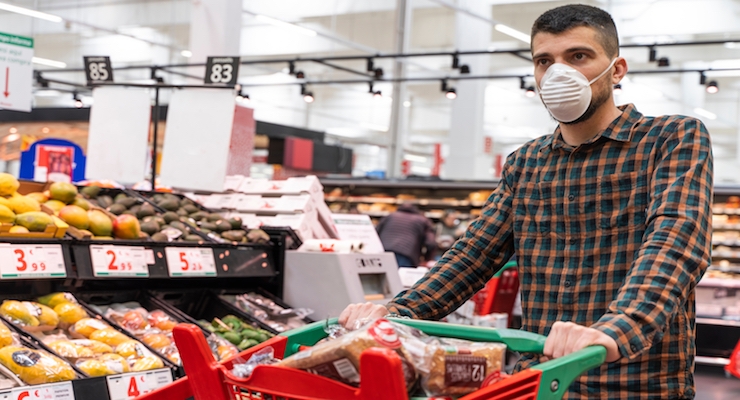Leading Food Authorities: No Evidence Food Can Transmit COVID-19
03.19.20
Because viruses most similar to COVID-19 are incapable of transmission via food products, EFSA says there is no evidence to support food transmission.
According to the European Food Safety Authority (EFSA) there is currently no reason to believe that food is a likely source or route of transmission of COVID-19.
“Experiences from previous outbreaks of related coronaviruses, such as severe acute respiratory syndrome coronavirus (SARS-CoV) and Middle East respiratory syndrome coronavirus (MERS-CoV) show that transmission through food consumption did not occur,” Marta Hugas, EFSA’s chief scientist, said.
The European Centre for Disease Prevention and Control (ECDC) said that while animals in China were the likely source of the initial infection, the virus is spreading from person to person, mainly via respiratory droplets that people sneeze, cough, or exhale.
Scientists and authorities across the world are monitoring the spread of the virus and there have not been any reports of transmission through food. For this reason, EFSA is not currently involved in the response to the COVID-19 outbreaks. However, we are monitoring the scientific literature for new and relevant information.
Regarding food safety, the World Health Organization (WHO) has issued precautionary recommendations including advice on good hygiene practices during food handling and preparation, such as washing hands, cooking meat thoroughly and avoiding potential cross-contamination between cooked and uncooked foods.
The U.S. Food and Drug Administration (FDA) corroborates EFSA’s assessment of the situation.
“Unlike foodborne gastrointestinal (GI) viruses like norovirus and hepatitis A that often make people ill through contaminated food, SARS-CoV-2, which causes COVID-19, is a virus that causes respiratory illness. Foodborne exposure to this virus is not known to be a route of transmission,” the agency said in a statement. “The virus is thought to spread mainly from person-to-person. This includes between people who are in close contact with one another (within about 6 feet), and through respiratory droplets produced when an infected person coughs or sneezes. These droplets can land in the mouths or noses of people who are nearby or possibly be inhaled into the lungs. It may be possible that a person can get COVID-19 by touching a surface or object that has the virus on it and then touching their mouth, nose, or possibly their eyes, but this is not thought to be the main way the virus spreads. However, it’s always critical to follow the 4 key steps of food safety—clean, separate, cook, and chill – to prevent foodborne illness.”
Additionally, FDA does not anticipate having to issue recalls or have products withdrawn from the market because of COVID-19. CGMPs require food processing facilities to use EPA-registered disinfectant products for COVID-19, as listed here.
“Experiences from previous outbreaks of related coronaviruses, such as severe acute respiratory syndrome coronavirus (SARS-CoV) and Middle East respiratory syndrome coronavirus (MERS-CoV) show that transmission through food consumption did not occur,” Marta Hugas, EFSA’s chief scientist, said.
The European Centre for Disease Prevention and Control (ECDC) said that while animals in China were the likely source of the initial infection, the virus is spreading from person to person, mainly via respiratory droplets that people sneeze, cough, or exhale.
Scientists and authorities across the world are monitoring the spread of the virus and there have not been any reports of transmission through food. For this reason, EFSA is not currently involved in the response to the COVID-19 outbreaks. However, we are monitoring the scientific literature for new and relevant information.
Regarding food safety, the World Health Organization (WHO) has issued precautionary recommendations including advice on good hygiene practices during food handling and preparation, such as washing hands, cooking meat thoroughly and avoiding potential cross-contamination between cooked and uncooked foods.
The U.S. Food and Drug Administration (FDA) corroborates EFSA’s assessment of the situation.
“Unlike foodborne gastrointestinal (GI) viruses like norovirus and hepatitis A that often make people ill through contaminated food, SARS-CoV-2, which causes COVID-19, is a virus that causes respiratory illness. Foodborne exposure to this virus is not known to be a route of transmission,” the agency said in a statement. “The virus is thought to spread mainly from person-to-person. This includes between people who are in close contact with one another (within about 6 feet), and through respiratory droplets produced when an infected person coughs or sneezes. These droplets can land in the mouths or noses of people who are nearby or possibly be inhaled into the lungs. It may be possible that a person can get COVID-19 by touching a surface or object that has the virus on it and then touching their mouth, nose, or possibly their eyes, but this is not thought to be the main way the virus spreads. However, it’s always critical to follow the 4 key steps of food safety—clean, separate, cook, and chill – to prevent foodborne illness.”
Additionally, FDA does not anticipate having to issue recalls or have products withdrawn from the market because of COVID-19. CGMPs require food processing facilities to use EPA-registered disinfectant products for COVID-19, as listed here.













